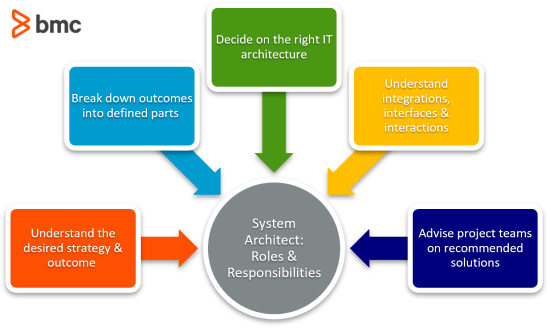In the ever-evolving world of IT, having strong systems and networks is crucial. Companies that are able to create goals surrounding their systems are sure to see growth, but they can’t stop there. It is necessary to have someone in charge of not only ensuring that these goals are met in terms of technology, but also that the technology is:
- Designed correctly
- Deployed efficiently
- Maintained across its lifecycle
Enter in: the system architect.
While professionals in this role might have more freedom in their overall daily job functions, there is still a general set of responsibilities required of them. We have put together some information to explain what a system architect does.

What is a system architect?
A system architect is in charge of devising, configuring, operating, and maintaining both computer and networking systems. They objectively analyze desired processes and outcomes and advise on the right combination of IT systems and components to achieve specific business, department, team, or functional goals.
System architecture is closely aligned with service design.
Similar to how civil engineers need to have a complete understanding of bridges and everything they encompass, system architects must be highly proficient in understanding:
- How much stress computer systems can take
- How they need to be used
- What is needed for the system designs to hold up
Levels of system architects
The system architect works at several different levels in IT, from high-level business strategy to low-level project consulting.
- At the highest level, system architects help to define and decide on the right IT strategy and approach that will best support long-term business plans and goals.
- At the medium level, system architects advise on the best tools, frameworks, hardware, software, and other IT elements to achieve mid-term departmental and functional objectives.
- At the lowest level, system architects consult with and advise project teams on the specific software, hardware, and other elements needed to deliver defined IT project outcomes.
System architects are business and technology experts. They look at business plans and goals, analyze technical solutions, and create recommendations on the right mix of IT elements to achieve those objectives.
The roles of a system architect
A system architect role can be split into five areas:
- Understand the desired business or departmental strategy and outcome.
- Break down those outcomes into defined parts including products, processes, and functions.
- Decide on the right architecture to achieve what they have defined.
- Understand software, hardware, and user interactions, integrations, and interfaces.
- Advise project teams on implementing their recommended solutions.
System architects are often senior engineers and strategists and work with stakeholders throughout IT and the business as a whole. They must absorb large amounts of information, analyze it for key factors, and provide clear, easily implementable recommendations.
Let’s explore the key parts of a system architect’s role:
Understand the desired business or departmental strategy and outcome
IT is a crucial component of almost every business process. When the business wants to launch new products, improve efficiencies, or gain a competitive advantage, this will be captured in the strategy.
A system architect will analyze business strategy and discuss all key areas and initiatives with business strategists and high-level managers. They will translate those requirements into a demand for new or enhanced IT capabilities over the short-, medium-, and long-term.
Break down outcomes into defined parts
Once the system architect understands business and departmental demands, they will analyze and understand what specific IT capabilities will be needed. They will define this in system architecture documents for each major initiative. This becomes an important reference document to ensure consistency and clarity across all project and IT implementations.
Documentation may include:
- The name, purpose, and outcome of the initiative
- The main features, functionality, and processes for the initiative
- Overall IT methodology and frameworks impacting the initiative
- Key existing infrastructure and applications
- New staffing or resource requirements
- Ideas for potential software and hardware solutions
Decide on the right IT architecture
When the business decides to implement an initiative, the system architect will build out the planned IT architecture model. They will recommend specific IT hardware, software, methodologies, and approaches to help the business achieve the desired outcome.
A system architect takes the following areas into account:
- Alignment with overall goals
- Specific business requirements
- The existing IT ecosystem
- New and established technologies
- IT resources and staffing
- Cost control and return on investment
- End user and customer needs and experience
- Availability, responsiveness, reliability, and resilience of critical elements
- Alignment with architecture standards and best practice
- IT service management and support
Understand integrations, interfaces & interactions
A system architect doesn’t just focus on IT elements in isolation. They also look at integrations with existing systems, interfaces with people and other applications, and how users will interact with the deliverable. UI and UX is becoming an increasingly important part of the system architect role, as well.
Advise project teams on recommended solutions
System architects work closely with project teams to help them turn the architecture and their vision into reality. They can advise on design and build, testing, and implementation. Feedback from engineers and end users will feedback into system design to ensure it aligns with both business goals and user needs.
Systems architect skills
While the specific skills needed for the role will vary according to the company and industry, there are some general skills needed to be a successful system architect:
- Experience with computer servers, network switches, load balancers, network analyzers, and network channel or data service units
- Knowledge of developing strategic system architecture plans
- Solid understanding of network and system development and deployment
- Strong analytical, problem-solving, and conceptual abilities
- Excellent verbal and written communication skills
- Experience with information processing fundamentals and best practices
- Ability to prioritize tasks, especially when under pressure
- Above-average leadership and collaboration abilities
Job outlook for the system architect
According to the Bureau of Labor Statistics (BLS), the job outlook for a systems architect is projected to grow about 5% from 2020 to 2030, a rate that is slower than the average for all occupations. Despite this, there is estimated to be over 11,000 job openings per year for the position.
Looking at the next decade, the need for this job will not go away. System architects hold an important position with the IT department, and overall company, and their skills are critical to the success of the organization’s infrastructure.
The system architect role is vital to the successful definition, design, delivery, and support of any IT project. Whether an organization is looking to create new systems, or is in the process of strengthening and growing already existing ones, having a qualified system architect on the team will make all the difference.







